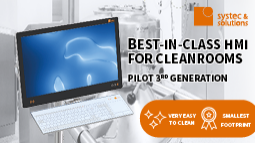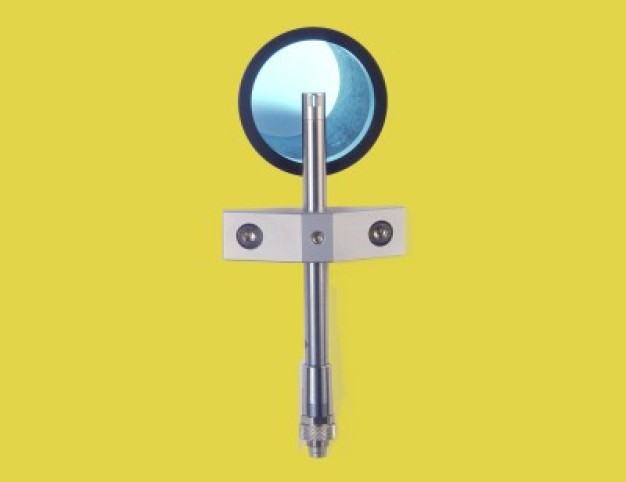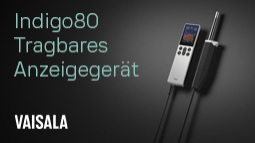Monitoring of the space rushing over
Introduction a new flow sensor from the house SCHMIDT Technology
offers completely new characteristics. In a very slim metal housing
hides itself a thermal flow probe, which can detect both the direction
of flow and the flow rate in two directions can measure. This probe
start, in order to improve within the range of the clean-room
technology the flow monitoring clearly. One of the applications is the
monitoring of the space rushing over. This report would like to point
out, what hides itself behind the term space rushing over, with which
means the space rushing over was so far determined and how the space
rushing over can be improved with the help of this new sensor. Space
rushing over, which is that? In pure areas if products are openly
processed, then it must be frequently guaranteed that contaminated air
from the neighbour areas does not penetrate into this area and thus
the open products damages.One can guarantee that either by the fact that the areas are
homogeneous closed (insulator technology) or thus that one guarantees
an obligatory rushing over of air from the area which can be protected
into the adjacent area. For this purpose in the area which can be
protected an excess air pressure is developed and prevented due to its
by each existing space opening air outward to flow and thus the
penetration of contaminated air. For the maintenance of this stable
situation it is usually sufficient to lead continuous supply air into
the area provided with positive pressure and to regulate with the help
of a differential pressure sensor the area on constant positive
pressure. With positive pressure than 15 Pascal and with almost
closely closed areas that is good larger to make. It acts however
around an area, that over doors frequently which can be opened ordered
or over large openings in the wall e.g..as product conveyors, then frequently such a large difference of
pressure can not be regarded at all. At these areas logically with
very small positive pressure it is worked and ensured product security
by the fact that one supervises rushing over air between the areas in
place of the differential pressure. Already if a suitable wall opening
is present, then one can attach measuring instrument in this opening.
Otherwise a special rushing over opening in the wall is attached. In
order it evaluates to be able, how the space differential pressure
affects the speed of rushing over, can in first approximation the
"Torricelli' discharge law" be used if one considers that this view
presupposes a thin wall and a hole of sufficient size.w=Wurzel from (2 x delta p/p) how: w = flow rate m/s delta p =
differential pressure [ Pa ] p = density of the medium [ kg/m^3 ]
under the conditions of a room air with 20°C with a standard air
pressure of 1013,25 hPas results in the computation the following
connection: Geschwindigkeitw [ m/s ] 0.01 0.13 0.1 0.41 1 1.29 5 2.89
10 4.08 15 5.00 20 5.77 30 7.07 on the basis this computation one can
recognize Differenzdruck [ Pa ] that a flow sensor attached in the
rushing over opening can prove then still another rushing over, if
only very small differential pressures are present. Past solutions the
most reliable solution, in order to prevent back flows between areas
is like already saying those to develop as high a differential
pressure as possible. In pharmaceutical pure areas differential
pressures between 15 and 30 Pascal are usual.That the adjusted differential pressure demanded rushing over produced
is proven with the acceptance checkings by the visualization of the
current by smoke particles. For the continuing monitoring of rushing
over frequently differential pressure sensors are used, which prove
that the necessary differential pressure will continuously maintain.
The weak point of this solution is to be kept upright that the
measuring signal of these sensors becomes instable with very small
differential pressures and forces thus to it, a relatively high
pressure. Alternatively in particularly brought in wall openings
windfahnen are used, from which one can read off the direction of
flow. Unfortunately this version is to be merged also relatively
insensitive and because of the not existing electrical interface also
not over the electronic Monitoringsystem. Alternatively partly also
normal flow sensors are used, which are set up in the rushing over
opening.Unfortunately these sensors cannot recognize, into which direction the
current flows. The operational principle of the new sensor the flow
sensor SS 20,400 is the first sensor from the house SCHMIDT its sensor
element you direction of a flowing air to recognize can. This sensor
works according to the principle of the thermal anemometer (also heat
wire principle called). The thermal Anemometer unterscheiden itself by
the following advantages of other air flow measurers: - minimum flow
rates are measurably (starting from 0,05 m/s) - no moved parts and
thus no wear - very small flow resistance b.z.w. small decrease of
pressure at measuring point the new sensor of the type SS 20,400 has
to exhibit still some further advantages, which are opened for us in
the following one.Element and electronics in the mini format to the protection against
mechanical load SCHMIDT built the sensor element into a chamber, was
then called the whole to "chamber head". It was ensured by a careful
aerodynamic organization of this chamber head that also a careless
assembly of the sensor (easy rotating to the flow axle or dumps
against the sensor axle) has a lowest possible reaction to the result
of measurement. In the feeler pipe directly behind the sensor element
super+small evaluation electronics, it sits looks thus in vain for an
external transducer. A microprocessor, which is connected with the
external world by the following connections, forms the core of
electronics: Analogue output 4... 20 mA 0..10 V, direction exit,
threshold value exit (both as open Collector) and R-S 232 interface.
The analogue output supplies a linear output signal both with forward
and to air with flowing backwards.Over the serial interface the user can adjust the sensor exactly to
its needs. In addition offers SCHMIDT Technology a programming kit,
which is to be served over a PC simply. The advantages of the new
sensor · clear direction recognition · fairs into two directions ·
very fast responsing mode in the ms range · switching exits built
therefore also as guards to the direct alarm giving applicable · very
small dimensions · over PC parametrierbar · inserted contamination
recognition · GMP suitable materials technical data design: Immersing
probe (Ø 9 x 150 mm of inclusive. Stecker),  transducers in the
feeler pipe integrates. Area of application: Freely flowing air and
led air in pipes of 15 to 1,000 mm Messbereiche:Â 1/2.5/10/20 m/s (in
both directions) measuring range beginning: 0.05 m/s pressure:
atmospherically, 700..1300 hPa assembly: alternatively wandhalterung, flange or passage
screw connection supply: 12... 24 VDC/under 10 mA of exits: possesses
0/4... 20 mA, 0..10 V, 0..5 V, 2 open Collector of exits for direction
and threshold value R-S 232 to the Parametrierung the application of
the new sensor of the SCHMIDT flow sensor SS 20,400 all
characteristics, in order to be able to supervise rushing over
mentioned before reliably. For the assembly of the sensor before the
rushing over opening there is a suitable wall assembly flange. Into
these the thin probe is screwed in and adjusted in such a way that the
sensor element comes to lie in the center of the opening and that the
feeler slot with the axle of the opening aligns. With the help of the
analogue output the speed of air flowing by the rushing over opening
can be supervised now.Since the sensor already measures starting from 0,05 m/s can a rushing
over also is still proven if the differential pressure is already no
longer clearly measurable. If the sensor can prove no more
Vorwaertstroemung or if a back flow takes place, then it announces
this condition over its switching exit OC1. With the help of the
programming kit the user can absorb the analog signal of the sensor
and stop the trigger levels of the switching exits themselves. Thereby
can be ideally configured the sensor for each application. The new
sensor is offered in different variants. Thus still further
application possibilities within the range of the clean-room
technology are opened for it: Laminar flow monitoring volume flow
measurement in and exhaust air ducts cooling air monitoring flow
control in inert gas atmospheres result the flow sensor SS 20,400
opens new possibilities for the flow monitoring in pure areas.Particularly for the monitoring of the space rushing over this sensor
can book the following pluses: · stable measuring signal also with
smallest differential pressures · avoidance of rash alarms · simple
assembly · easy to clean in the inserted condition · fast installation
and removal (e.g. for calibration) · calibration in each good wind
tunnel possible references: Stoecker, paperback of physics, 2. Edition
1994









